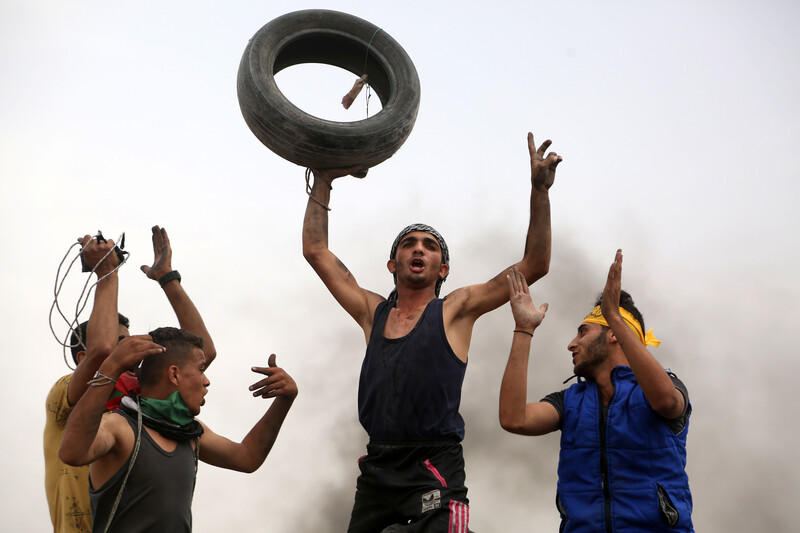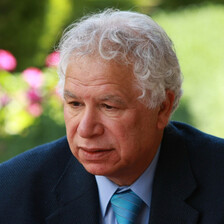The Electronic Intifada 7 May 2018

Brave protesters in Gaza are making history.
ActiveStillsThere are words bursting to come out of our throats, bubbling angrily like magma. They melt away our guts and veins, every part that keeps us alive.
The anger has been boiling since we grew up as refugees in a dusty old camp in the Gaza Strip, walking barefoot in the mud, queuing up every month waiting for our rations of flour, dried milk and corned beef from the United Nations.
It has been boiling since we started work at the age of 9, since we saw Israeli jeeps and bullets. We saw them before, during and after an intifada. We saw them when “peace” talks were taking place and when there were no such negotiations. We saw them regardless of whether the Oslo accords had been signed or not.
Now all these things are part of our memories, jumbled up with images of curfews, checkpoints, fences, walls, helicopters, F-16s.
They come back to us as we watch something new happening in Gaza, as we see our friends and families marching peacefully for their right of return.
Each Friday for the past several weeks, we have been sitting here in Europe, holding our breaths, hoping that our people back in Gaza are safe.
The images we see make us wonder how we could have lived in that open-air prison as children. We wonder how children can still live there and how those Israeli soldiers can be so heartless to point their guns at, pull the trigger and kill unarmed protesters.
We search the Internet for news. We speak to our parents in Gaza to make sure that nobody we knew has been killed. If we hear of anyone we know being hurt, we hope that the injuries are not serious.
After holding our breaths each Friday, we are silent on Saturday. We struggle to tell our children what we are thinking or explain what is happening in Gaza right now.
How do I answer my 8-year-old son when he asks why Israeli soldiers shot a child who flew a kite? Or a protester who burned a tire?
Cries for help
How far back in history do I need to go? And how is that going to help him understand?
How can I explain to my 4-year-old daughter that I really do have parents, that – although she has never met them – they do exist? That I haven’t made them up?
On Sunday, we iron our shirts. We get ready for the week ahead, to become anonymous in the Monday rush hour traffic.
We try to ignore those words still bursting to come out, words of rage, words of a grief that can’t really be expressed, cries for help from somewhere.
We go through our workdays, ignoring headlines from the BBC and The Guardian about the “clashes” on the “Gaza-Israel border.”
We avoid conversations with colleagues about our homeland and bury our heads in work that will make someone else richer.
And so it goes on – until Israel’s next major attack on Gaza, until the next image of a child being killed appears in the mainstream media, until the next time the world decides to pay attention for a few seconds.
Amid our anger, sadness and frustration, we can still admire the creativity and determination of our great people. These qualities can be observed in how the Gaza protesters conduct themselves: from their use of tires, mirrors, kites and V for Vendetta masks to the brave way they hold hands to protect someone running away from Israel’s bullets.
When we think about this creativity, we switch off BBC Radio 4. Instead of listening to “experts” talking about Brexit, we play a recording of Mahmoud Darwish reciting his poem “Ana Min Hunak – I Am from There.”
Shadow of a siege
We, diaspora Palestinians from the Gaza Strip, have been living “out of siege” for more than a decade.
You can imagine what a siege looks like; it’s often associated with closures and lack of resources.
Living “out of siege” is equally difficult. It is the pain of waiting, watching the news from the Rafah crossing every day, trying hard to keep in touch with family, trying to explain what the siege means in everything we post on Facebook or Twitter and in every conversation we have with friends and colleagues.
Living “out of siege” also involves closure. It means being locked out of your native land. It has been more than five years since I have been able to visit Gaza, my home.
This year marks the 70th anniversary of the Nakba – the catastrophe. The date on which Israel was established – 15 May 1948 – is forever etched in our minds. The Nakba has never stopped.
Not alone
The Nakba has forced many of us to live in refugee camps and sent others away to live in exile.
It is because of the Nakba that my father has to suffer when he cannot find the medicine that he needs. It is because of the Nakba that my aunt has been unable to travel for surgery that she urgently needs, yet is unavailable in Gaza’s hospitals.
Every year we join protests and conferences in London. We talk about the right of return for Palestinian refugees and about our plight as Palestinians from Gaza.
We sit on panels and explain the situation to a sympathetic audience. We feel a little better having done so.
Then we go home. We do the same thing the following year: go to another conference.
But this year we are trying something different. We are working with a number of organizations in London to celebrate the beauty of the Palestinian culture, to shout out loud and say we have a wonderful heritage we want the world to appreciate.
We are holding a week-long festival of theater, dance, films and talks commemorating the Palestinian experience of dispossession and loss of a homeland. It will be poignant, but it will also be defiant.
We don’t know if this is going to make a difference to people here in the UK. And we don’t know if we will be able to change anything on the ground for our brave people in Gaza as they continue to make history.
But we wanted to be with them, too, in our own way. We wanted to encourage their creativity and enthusiasm and to make sure that they don’t feel they are left alone.
We cannot give up our right to our land and we must keep on fighting for the justice that the Nakba denied us. We will continue to do so creatively, whether we are in Palestine, London or anywhere else.
The festival @70: Celebration of Contemporary Palestinian Culture takes place in Rada Studios, London from 14 to 20 May.
Ahmed Masoud is a writer, director and academic based in the UK. His plays include Camouflage, Walaa (Loyalty), Unto the Breach and Go to Gaza, Drink the Sea. He is also the author of the acclaimed novel Vanished: The Mysterious Disappearance of Mustafa Ouda. Website: www.ahmedmasoud.co.uk




